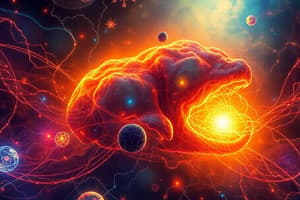Podcast
Questions and Answers
What part of the brain is most known for its role in fear and threat detection?
What part of the brain is most known for its role in fear and threat detection?
- Occipital lobe
- Frontal lobe
- Amygdala (correct)
- Cerebellum
Which brain region is responsible for higher-level reasoning and decision making?
Which brain region is responsible for higher-level reasoning and decision making?
- Hippocampus
- Brainstem
- Cerebral cortex (correct)
- Temporal lobe
What change occurs in the adolescent brain that makes them more likely to focus on the positive aspects of choices?
What change occurs in the adolescent brain that makes them more likely to focus on the positive aspects of choices?
- Greater fear response
- Increased hyper-rational thinking (correct)
- Decreased activity in the amygdala
- Enhanced judgment skills
Which part of the brain is involved in evaluating whether something is good or bad during adolescence?
Which part of the brain is involved in evaluating whether something is good or bad during adolescence?
What is the term used to describe the adolescent's tendency to focus on the positive aspects of choices?
What is the term used to describe the adolescent's tendency to focus on the positive aspects of choices?
Which brain part regulates the body's automatic functions like breathing and heartbeat?
Which brain part regulates the body's automatic functions like breathing and heartbeat?
Flashcards are hidden until you start studying
Study Notes
The Adolescent Brain and Emotions
- The limbic area of the nervous system, which works closely with the brainstem and body, creates emotions, and in adolescents, it exerts more influence on higher-level reasoning.
- In adolescents, emotional responses are more intense, and their amygdala activates even when shown a neutral face, making them think someone is having a negative emotional response.
- This increased emotionality can lead to adolescents becoming more easily irritated, upset, and moody.
Brain Development and Risk-Taking
- During adolescence, the brain starts to focus on the positive aspects of a choice and minimizes the negative aspects, leading to hyper-rational thinking.
- This hyper-rational thinking makes adolescents more likely to engage in risky behaviors, such as driving fast, taking narcotics, or engaging in risky sexual behavior.
The Importance of Novelty in Adolescence
- Adolescents have an innate drive for novelty, which is why they can get bored with the same routine.
- Schools need to adapt to this drive by changing their approach to the school experience and providing more opportunities for novelty and excitement.
Studying That Suits You
Use AI to generate personalized quizzes and flashcards to suit your learning preferences.




